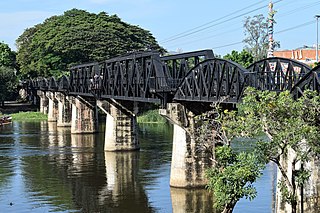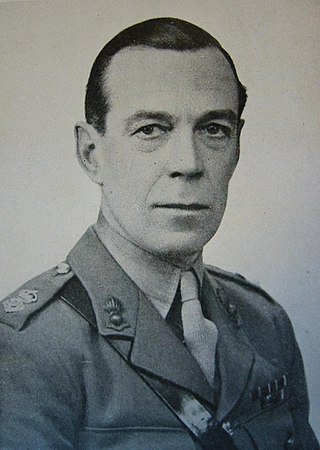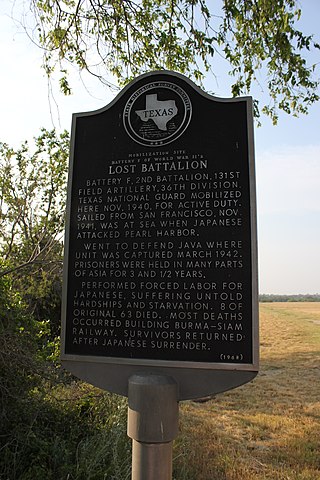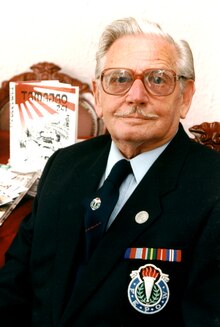
The Bridge on the River Kwai is a 1957 epic war film directed by David Lean and based on the 1952 novel written by Pierre Boulle. Boulle's novel and the film's screenplay are almost entirely fictional, but use the construction of the Burma Railway, in 1942–1943, as their historical setting. The cast includes William Holden, Alec Guinness, Jack Hawkins, and Sessue Hayakawa.

The Burma Railway, also known as the Siam–Burma Railway, Thai–Burma Railway and similar names, or as the Death Railway, is a 415 km (258 mi) railway between Ban Pong, Thailand, and Thanbyuzayat, Burma. It was built from 1940 to 1943 by South East Asian civilians abducted and forced to work by the Japanese and a smaller group of captured Allied soldiers, to supply troops and weapons in the Burma campaign of World War II. It completed the rail link between Bangkok, Thailand, and Rangoon, Burma. The name used by the Japanese Government was Tai–Men Rensetsu Tetsudō (泰緬連接鉄道), which means Thailand-Burma-Link-Railway.

Changi Prison Complex, often known simply as Changi Prison, is a prison complex in the namesake district of Changi in the eastern part of Singapore. It is the oldest and largest prison in the country, covering an area of about 50 ha. Opened in 1936, the prison has a rich history.

The Sandakan Death Marches were a series of forced marches in Borneo from Sandakan to Ranau which resulted in the deaths of 2,434 Allied prisoners of war held captive by the Empire of Japan during the Pacific campaign of World War II at the Sandakan POW Camp, North Borneo. By the end of the war, of all the prisoners who had been incarcerated at Sandakan and Ranau, only six Australians survived, all of whom had escaped. It is widely considered to be the single worst atrocity suffered by Australian servicemen during the Second World War.

To End All Wars is a 2001 war film starring Robert Carlyle, Kiefer Sutherland and Sakae Kimura and was directed by David L. Cunningham. The film is based on Through the Valley of the Kwai, an autobiography of Ernest Gordon, then a Scottish Captain, later the Presbyterian Dean of the Princeton University Chapel.

Brigadier Sir Philip John Denton Toosey was, as a lieutenant colonel, the senior Allied officer in the Japanese prisoner-of-war camp at Tha Maa Kham in Thailand during World War II. The men at this camp built Bridge 277 of the Burma Railway as later fictionalized in the book The Bridge over the River Kwai by Pierre Boulle, and since adapted into the Oscar-winning film The Bridge on the River Kwai in which Alec Guinness played the senior British officer, Lt Col Nicholson. Both the book and film outraged former prisoners because Toosey did not collaborate with the enemy, unlike the fictional Lt Col Nicholson.

The Bridge over the River Kwai is a novel by the French novelist Pierre Boulle, published in French in 1952 and English translation by Xan Fielding in 1954. The story is fictional but uses the construction of the Burma Railway, in 1942–1943, as its historical setting, and is partly based on Pierre Boulle's own life experience working in rubber plantations in Malaya and later working for allied forces in Singapore and French Indochina during the Second World War. The novel deals with the plight of World War II British prisoners of war forced by the Imperial Japanese Army (IJA) to build a bridge for the "Death Railway", so named because of the large number of prisoners and conscripts who died during its construction. The novel won France's Prix Sainte-Beuve in 1952.
Ernest Gordon was the former Presbyterian dean of the chapel at Princeton University. A native of Greenock, Scotland, and the son of James Gordon and Sarah R MacMillan, as an officer in the Argyll and Sutherland Highlanders, Gordon spent three years in a Japanese prisoner of war (POW) camp during the Second World War. He chronicled his experiences on the Death Railway in his book Through the Valley of the Kwai. The book served as an inspiration to the film To End All Wars, where he was portrayed by actor Ciarán McMenamin. The film opened in 2001, and the film's DVD release, which came out after his death, dedicated the film to his memory.

Eric Sutherland Lomax was a British Army officer who was sent to a Japanese prisoner-of-war camp in 1942. He is most notable for his book, The Railway Man, about his experiences before, during, and after World War II, which won the 1996 NCR Book Award and the PEN/Ackerley Prize.

Burhan-ud-Din (1914–1996) of Chitral was a veteran of the Indian National Army. Burhan-ud-Din was the son of Mehtar Shuja ul-Mulk, the ruler of Chitral. He was by far the most famous Chitrali as a result of his service in the Indian National Army under Subhas Chandra Bose during World War II.

Lionel Colin Matthews, was an Australian Army officer in World War II. He was posthumously awarded the George Cross, the highest award for extraordinary acts of gallantry away from the field of battle that could be awarded to a member of the Australian armed forces at the time. Matthews was born in Adelaide, South Australia, and was schooled there before moving to Victoria. He trained as a signalman in the Royal Australian Naval Reserve before joining the Militia in April 1939. Commissioned as an officer in the Australian Corps of Signals, Matthews transferred to the 8th Division of the Second Australian Imperial Force after the outbreak of World War II.

Percy Herbert was an English actor. He worked predominantly from the 1950s into the 1970s and became one of the most recognisable faces in post-war British cinema.
Through the Valley of the Kwai is the autobiography of the Scottish captain Ernest Gordon, and recounts the experiences of faith and hope of the men held in a Japanese prisoner of war labour camp, building the Burma Railway during World War II.

Santo Tomas Internment Camp, also known as the Manila Internment Camp, was the largest of several camps in the Philippines in which the Japanese interned enemy civilians, mostly Americans, in World War II. The campus of the University of Santo Tomas in Manila was utilized for the camp, which housed more than 3,000 internees from January 1942 until February 1945. Conditions for the internees deteriorated during the war and by the time of the liberation of the camp by the U.S. Army many of the internees were near death from lack of food.

Brigadier Arthur Leslie Varley, MC & Bar was an Australian soldier who served in the First and the Second World Wars. He was commander of the 22nd Infantry Brigade during the final stages of the Battle of Singapore in the Second World War. Having surrendered to the Japanese, he was responsible for over 9,000 prisoners of war engaged in the construction of the Burma-Thailand Railway. He was killed in September 1944 when the transport ship taking him and several hundred fellow prisoners to Japan was sunk by an American submarine.
Takashi Nagase was a Japanese military interpreter during World War II. He worked for the Kempeitai at the construction of the Burma Railway in Thailand, and spent most of his later life as an activist for post-war reconciliation and against Japanese militarism. He made over a hundred visits to Thailand, and from the 1970s, arranged several meetings between former Allied prisoners of wars and their Japanese captors, in efforts to promote peace and understanding. In 1993, he met and reconciled with British former POW Eric Lomax—in whose torture sessions Nagase had been involved—an encounter retold in Lomax's 1995 autobiography The Railway Man.

The Lost Battalion was the 2nd Battalion, 131st Field Artillery, 36th Infantry Division of the U.S. Army. The men of the battalion, plus the survivors of the sunken cruiser USS Houston, were captured by the Japanese on the island of Java in the Dutch East Indies in March 1942. It is called the lost battalion because the fate of the men was unknown to the United States until September 1944. They were prisoners of war for 42 months until the end of World War II. 534 soldiers from the battalion and 368 survivors of Houston were taken prisoner. Most of the men were sent to Thailand to work on the Burma Railway, the building of which is portrayed in the film The Bridge on the River Kwai. Of the 902 soldiers and sailors taken captive, 163 died in captivity. Most of the prisoners of war were from western Texas.

Hilton House Hotel, in Derby, England, is a building of historical significance. It is a Georgian house which was the ancestorial home of Herbert Martin Massey. He was the Senior British Officer at Stalag Luft III who authorised the "Great Escape". The hotel closed in February 2023.

Tamarkan was a Japanese prisoner of war work camp during World War II. The camp was initially used for the construction of the bridge over the Khwae Yai or Mae Klong River and not the River Kwai. The camp was located about five kilometres from the city of Kanchanaburi. In November 1943, Tamarkan was turned into a convalescent camp and hospital. By 1945, the camp was gone.


















